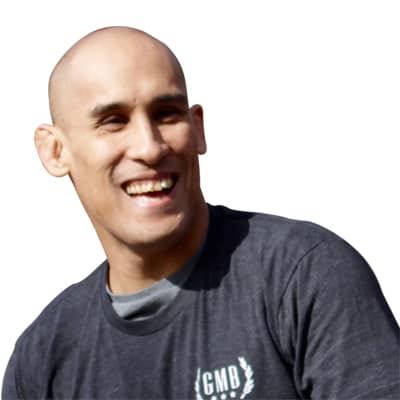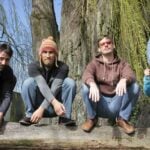If you’re reading this, you probably enjoy doing challenging things with your body — the feeling of pushing your limits, the confidence in knowing you can do things most people can’t.
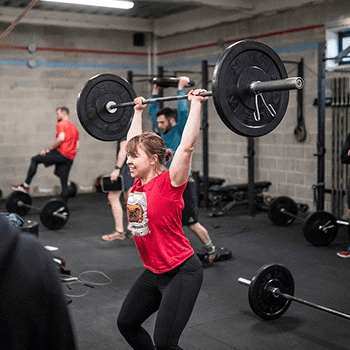 But ask yourself this: Will you still be able to do this stuff 20 or 30 years from now?
But ask yourself this: Will you still be able to do this stuff 20 or 30 years from now?
We all know that our bodies change as we get older. And you’ve probably seen people in the generations above you (and maybe people your own age) get weak and stiff and lose the ability to do the things they love.
But the truth is, while your body will change, that doesn’t have to make you less capable.
Because, while the average person will slowly lose capability for most of their adult years, there are simple strategies to maintain and even improve what your body can do as you get older.
In this article, I’ll lay out the three major ways most people’s bodies decline as they get older. And I’ll share three key strategies that you can use to make sure you build and maintain the capabilities you want for a lot longer than most people think is possible.
But first, here’s a short video of Ryan talking about some of the changes he’s experienced in his training as he’s grown older.
Fitness at 45 vs Fitness at 25
Does that resonate?
And yeah, we get that 45 isn’t old… but the change in perspective and priority is salient at any age, and it’s something we’ve learned by working with clients of all ages (from about 4 to 102 years old).
If you can relate to Ryan’s experiences, you’re definitely in the right place. Read on.
The 3 Biggest Challenges Of Getting Older
Getting older is a fact of life, but the experience along the way is very different for different people.
There seem to be two main camps:
- After a certain age, you’re just going to get worse. There’s nothing you can do about it. It just is.
- Aging doesn’t really have to happen. If you experience any decline in your performance, it’s because you didn’t eat the right foods, do the right exercises, take the right supplements, etc. It’s a choice.
These are two extreme positions, and neither one explains the full picture. There’s a middle ground:
The body does go through certain physiological changes as you get older, which can make some things more challenging. However, there are actions you can take to decrease these challenges.
In this section, I’ll go over the three biggest changes that occur with age, and how a dedicated exercise practice can impact these changes.
Loss of Strength
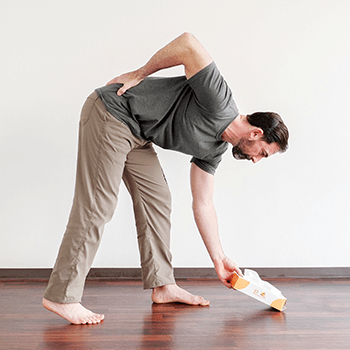 When you think of common characteristics of older people, weakness or frailty probably come to mind.
When you think of common characteristics of older people, weakness or frailty probably come to mind.
As people get older, there is a definite decline in strength, but the age at which that sets in and the severity of the decline will depend largely on a person’s exercise habits. There’s a big difference between a lifelong exerciser who’s weaker in his 70s than he was at 30 and a lifelong couch potato who breaks her hip at 68-years-old.
Take a look at the natural declines in strength non-exercisers go through over the course of a lifetime, compared to what many lifelong exercisers experience.
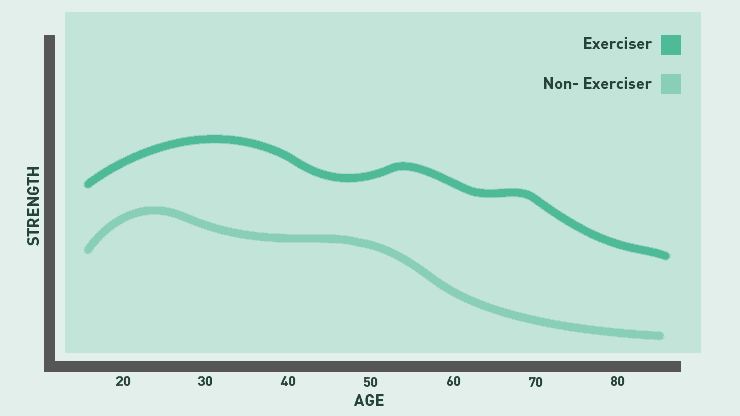
The most important thing to note is that, while both categories of people experience a decline in strength, exercisers are able to hold on to their strength much better for a lot longer. The decline is much more steep for sedentary people.
So, while you can expect to lose some strength as you get older, as long as you continue to exercise consistently, you could be doing things at 80 that most people can’t do at 20.
Decrease in Flexibility
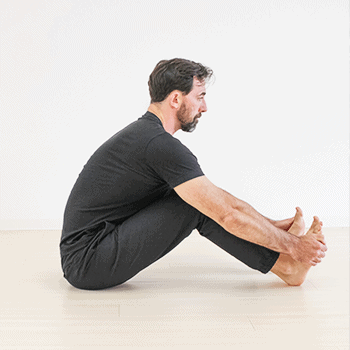 Flexibility is something people of all ages struggle with, but the decline past age 55 or so is pretty significant. One study showed a decrease in shoulder flexion of 5-6 degrees per decade, and a decrease in hip flexion of 6-7 degrees per decade.
Flexibility is something people of all ages struggle with, but the decline past age 55 or so is pretty significant. One study showed a decrease in shoulder flexion of 5-6 degrees per decade, and a decrease in hip flexion of 6-7 degrees per decade.
That’s a huge difference over several decades of life!
Even if you are currently quite flexible, just imagine how limited your life would be if you lost 5-20 degrees of flexion in any joint.
The good news is flexibility training can have a significant impact on retaining and increasing range of motion as you get older, even if you’ve lost some of the flexibility you may have had when you were younger.
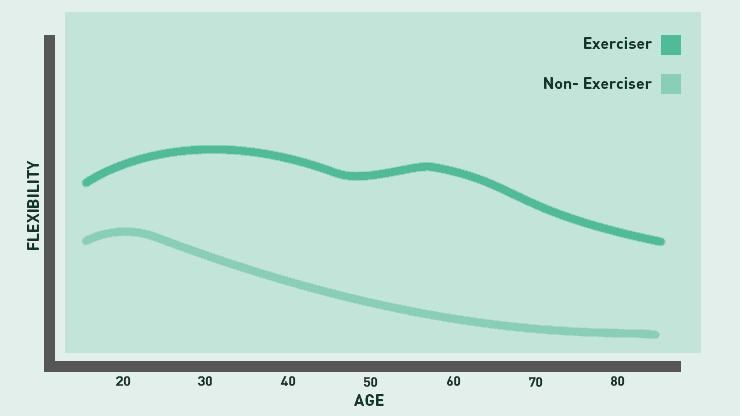
You probably know many people who start bemoaning the flexibility they “once had” the minute they start to feel some changes in their natural flexibility. But losing flexibility is only a given if you don’t do any flexibility training.
Impaired Motor Control
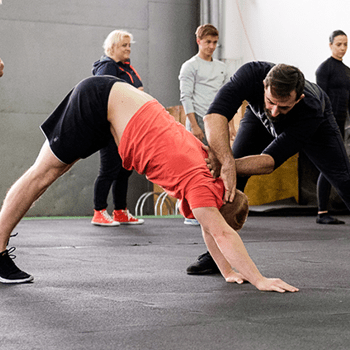 The third area people experience challenges with as they age is motor control.
The third area people experience challenges with as they age is motor control.
This is, arguably, the most dangerous of the three, as it’s what’s responsible for older people losing balance and falling, as well as other potentially life-threatening consequences of poor coordination.
Motor control is what allows you to put your flexibility and strength into controlled motion. It’s something that people of all ages struggle with because it’s not typically emphasized in traditional exercise programs, but that doesn’t make it any less important.
Without specifically training to improve your motor control, you can expect to lose quite a bit of coordination as you get older. Proper training, though, can help you hold on to your motor control.
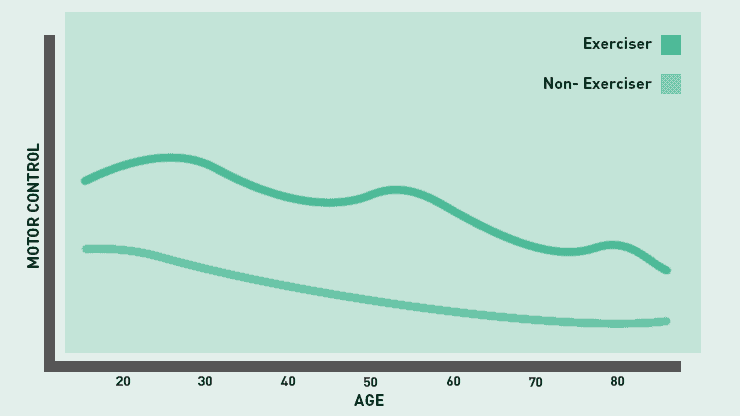
You’re probably not worried much about falling and hurting yourself now – you’re active and strong, and you know you can bounce back from a minor accident. But many adults over a certain age don’t have the same confidence.
Keep up your current training, and work on specifically training for improved motor control, and you’ll be able to retain that confidence 20, 30, or 40 years from now.
Next we’re gonna look at how menopause plays into all this.
If that’s not an issue for you, you can click here to skip to the next section about our favorite strategies for staying a badass as you get older.
🤷♀️ What’s Menopause Got To Do With It?
Odds are about half the people reading this will experience menopause as part of getting older. So let’s take a look at the main things you should keep in mind when it comes to menopause and training.
What’s going on in the body?
The primary marker of menopause is decreasing levels of estrogen and progesterone. This impacts the entire body from your muscles to nervous system to heart. Thankfully a lot of the negative effects can be mitigated and improved with physical activity.
Let’s take a closer look.
What changes in terms of fitness?
Menopause can have quite a few fitness and performance related impacts. Here are the main ones:
- Decreasing muscle mass, bone density, and metabolism—the last of which often leads to weight gain
- More stiffness and aches with decreasing flexibility
- Fatigue, sleep disturbances, and low moods can lead to less activity overall
All this can leave you feeling less capable and confident. Or at worst worried and frail. But consistent exercise can go a long ways towards keeping you moving and feeling strong.
How does training help?
Lots of research shows that consistent exercise is one of the best ways to mitigate the effects of menopause. Here’s how…
- Strength training helps you maintain and improve both muscle mass and bone density
- Mobility work reduces stiffness and aches, and helps keep your joints in good working order.
- Training your motor control improves your balance and coordination so you can move with confidence
- Consistent exercise helps you sleep better and reduces low moods
How to get started
First of all, it’s never too late to start. Even if it’s just 10 or 15 minutes a day. It makes a difference.
It’s never too early, either. Because the better your foundation is going into menopause, the easier it’ll be to stay capable and confident through it.
All that might sound like a lot to keep in mind. But if you follow a program like Elements that includes strength, flexibility, and control, then you just need to remember 3 simple principles:
- Be consistent – shoot for at least 3 training sessions per week.
- Work at your own level. Your training at 55 shouldn’t look like your training at 25.
- Use autoregulation to reduce your chances of injury or burnout.
Just like getting older, menopause is gonna happen. Your body will change. But regardless of what your hormones are doing, a good, consistent training practice will keep you stronger, less achey, and more resilient for many years to come.
3 (+1) Strategies to Continue Doing the Things You Love For As Long As Possible
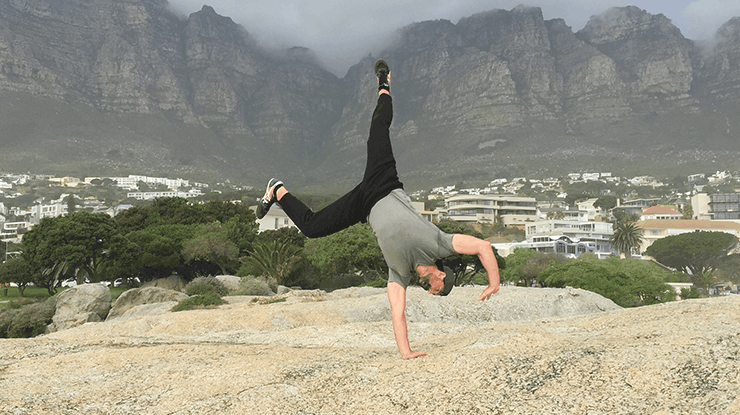
Being fit and healthy for all the things that you need and want to do with your life has little to do with your age and a lot to do with how you live your life.
I remember working in a hospital where there was a 90-year-old patient who was incredibly sharp and strong, and the only reason she was there was because she had broken her hip. I would compare her to a different patient, a 60-something man who could barely stand up and had been like that for years.
A closer look at their respective histories revealed that she was continuously active in all areas of her life, while his listed “hobbies” included watching TV and drinking.
Certainly, there are medical conditions and such that can occur more frequently in older folks, but excluding that, the primary indicator of quality of life as we age is how active we remain. The fountain of youth exists, and it’s been proven again and again to be exercise.
The following three strategies will help you continue to do the things you love for a lifetime.
1. Don’t Stop Moving the Way You Want to When You’re 70
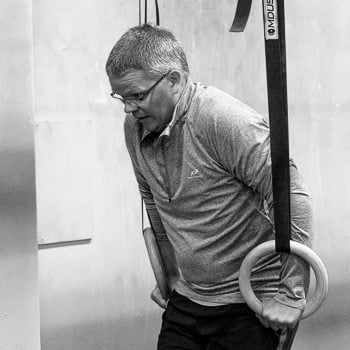 There are countless examples of masters-level weightlifters, gymnasts, runners, martial artists, and other athletes that have prolonged competitive careers.
There are countless examples of masters-level weightlifters, gymnasts, runners, martial artists, and other athletes that have prolonged competitive careers.
What is it that distinguishes these lifelong athletes? What keeps them going when many others are content watching old footage of themselves while digging into the next bag of chips?
These lifelong athletes simply never stopped.
Though your absolute level of strength will decrease as you get older, and you’ll likely not be hitting personal bests when you are 70, your relative strength as compared to your peers who don’t exercise will be quite high.
And at a certain point, even maintaining a level of strength will put you head and shoulders above everyone else.
The important thing, though, is to think about how you want to be moving 20, 30, 40 years from now. Start moving that way now if you haven’t gotten started, and just keep at it. That’s what will ensure your success much further down the line.
Having a passion and joy for moving your body, and training and working hard because the very act means something to you – these are all part of the recipe for lifelong fitness.
So find something you enjoy, something you want to do for as long as possible, and there’s a good chance you’ll still be going many years from now.
2. Cycle Your Training Focus
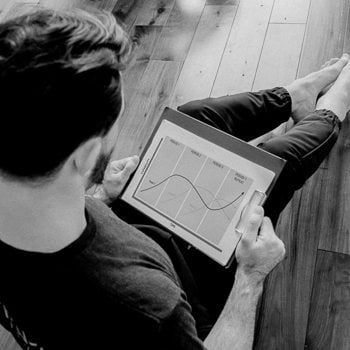 One key component of the GMB Method is the concept of cycling your goals.
One key component of the GMB Method is the concept of cycling your goals.
This idea is applicable throughout your training lifetime, and perhaps even more so for the older trainee. The concept of a focused approach performed for periods of time that cycle over and over is a tried and true productive approach in all areas of physical training.
Periodization is simply the planned cycling of your training to improve specific goals.
Rather than attempting to do everything at once in your workouts and spinning your wheels, a targeted plan of attack for a short period of time is much better for continued progress.
It’s also much easier on the body than banging away at the same workouts, with the same intensity.
Even for youngsters, that would be a quick trip to a dead end. Patient, directed, consistent effort will always win out over frenzied, unfocused, and transient exertion.
3. Tackle Your Weaknesses Now
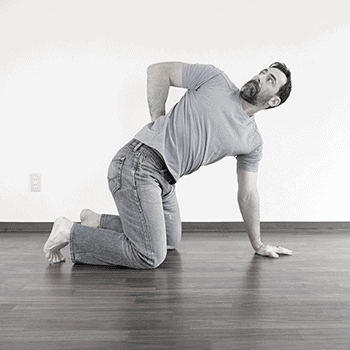 As we covered above, you can expect your strength, flexibility, and motor control to be lower at 80 than at 30, but the degree to which they decrease will depend on your activities.
As we covered above, you can expect your strength, flexibility, and motor control to be lower at 80 than at 30, but the degree to which they decrease will depend on your activities.
Take a hard, critical look at your current levels of strength, flexibility, and motor control.
Though we can always improve, there are often glaring deficiencies that we tend to gloss over and think “oh, I’ll work on it later.” Well, later needs to be now if you want to get anywhere.
A systematic approach to tackling your weaknesses doesn’t mean neglecting everything else.
The easiest tactic is to prioritize that lagging area by moving it to the beginning of your routine. After your warm-up, your energy level is higher and you are more likely to get it done than you would by tacking it on to the end of your workout. Work on it first with good concentration and then move on to your other training.
Taking the time to bring up your deficits leads to bigger and better improvements later on, and for the rest of your training life. Have the discipline to start on it now and you’ll reap the benefits for years.
Bonus: Focus on Recovery
In the video at the top of this article, Ryan mentions the importance recovery as he’s aged, and it’s something we should all be conscious of in our training.
Rather than gloss over this topic in a few sentences here, I’ll just direct you here:
👉 Our 4 Best Recovery Strategies for Faster Recovery
Find Role Models That Keep You Motivated
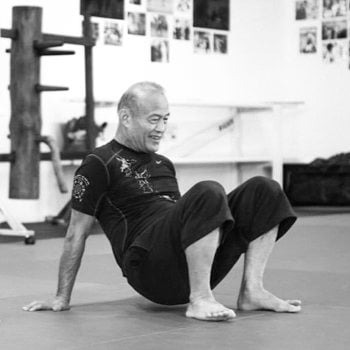 A lot of our ideas about age and health come from our own experiences with our own families and the media.
A lot of our ideas about age and health come from our own experiences with our own families and the media.
If those don’t offer much inspiration, seek better role models.
In the last few years, I’ve had the opportunity to attend seminars with two Filipino martial arts masters. Watching them in person really hit home the value of being active every day of your life.
- Guro Dan Inosanto is amazingly fast, coordinated, and powerful. It’s not an exaggeration to say he easily puts most 30-year-olds to shame. He teaches regularly at his academy in California and has maintained a grueling weekend seminar schedule for over 40 years, all the while continuing to train and attend classes himself. Here’s a clip from when Guro Dan was 77 years old.
- Grand Tuhon Leo Gaje maintains an extraordinarily high level of dexterity and strength for a man of any age. He demonstrated training with a 12-pound shot put, hitting and gripping the steel ball while tossing and juggling it around. Upon passing it around to the seminar attendees (who were all more or less half his age), only a few of us could replicate what he was doing. This video was taken when GT Gaje was 75 years old.
These two exude not just physical skill, but also a keen sharpness of mind. Both are true role models, and testaments to the ability to be fit and vigorous throughout one’s lifespan.
If you’re not into martial arts, find other role models in another sport or activity you enjoy who do the things you want to be doing as you get older. Look to these people for inspiration, so you can keep yourself motivated and engaged for as long as possible.
Stay Young at Any Age
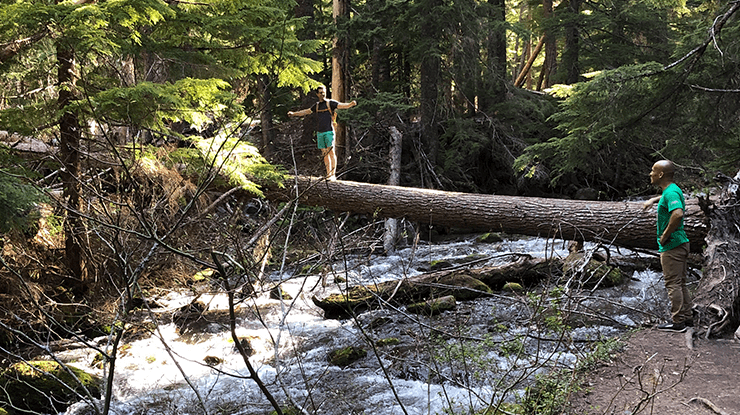
Being “young” isn’t just about your age. It’s about what you can do, and the confidence you have in your body.
Too often, people succumb to an all-or-nothing approach to training after a certain age. They think it’s “too late” to start, or things are only bound to go downhill at a certain point so it’s futile.
It’s a shame that so many people view it that way, as there is so much value to be gained from a more realistic approach.
Yes, your body will change as you get older. But there’s so much you can do to ensure you’re starting from a good point, and that you can maintain as much of your strength, flexibility, and motor control for as long as possible.
One of the best things you can do to avoid losing your strength, flexibility, and motor control in the rapid fashion many people do, is to build them up now, giving yourself a strong foundation. Our Elements program has helped thousands of clients build these attributes so they last a lifetime.
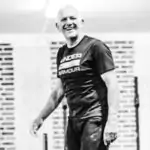
I joined Elements after a back injury during a Crossfit session. Thanks to the COVID lockdown I had no other choice to work at home on the WHY it happened and HOW to prevent such injury. My coach told me that the recovery path should be based on a thorough work on core and mobility.
I am now in week 6 of Elements and really enjoying it. The progress has been great in terms of agility and motor control. The back pain is gone after just a week of practice. As soon as the lockdown eases I will resume my training at the box but no longer with the same attitude. What GMB gave me is an opportunity to reconsider my approach to physical training with less pressure and more understanding of what is happening with my body.
Thanks for this great program.
Build A Strong Foundation; Be A Badass for Life
With Elements, you can develop strength, flexibility, and motor control—no matter your age—and maintain it for a lifetime of being fit and active.


